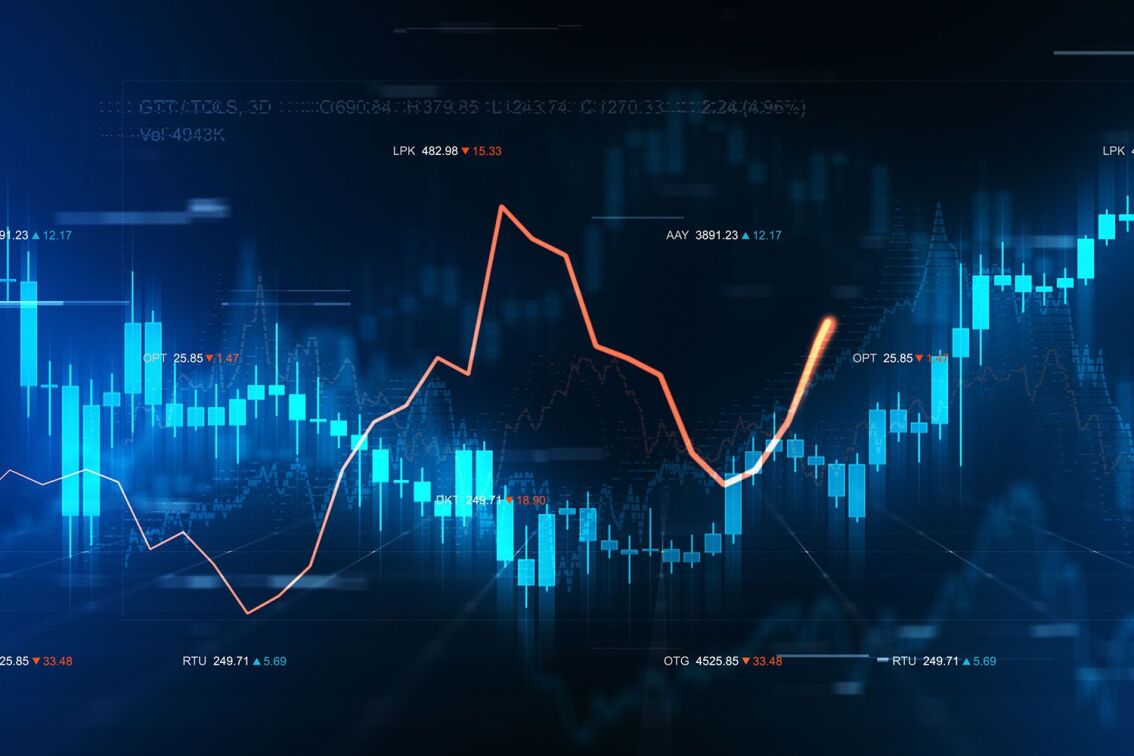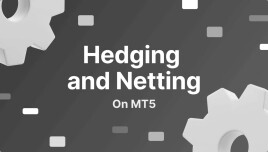
Hedging Method: This method, available only in the MetaTrader version of the DIAS robots, allows for opening and holding multiple trades in both directions (long or short) simultaneously. Moreover, open trades do not affect each other and can be managed and closed individually, each with its own financial management.
What does financial management mean in algorithmic trading?
When we talk about financial management in trading on financial markets, we refer to a defined and consistent approach from the time trades are opened until they are closed. In futures markets, where two-way trading (long or short) is possible, the structure of the strategy and the algorithm used determines two primary strategies for financial management
Netting Method: In this method, the ability to average down the value of trades (reducing the average price by increasing the volume of open trades in the same direction) is one-sided. Therefore, it is not possible to have two trades open in opposite directions (long and short) at the same time. New orders affect existing orders, and the position size can only increase or decrease in the long or short direction. If an order is placed in the opposite direction of an open position, the open position size is reduced.
The DIAS robots operating on crypto brokers such as Bybit and Binance use only this method for financial management due to the limitations of TradingView.

Risk management in financial trading, particularly when engaging in two-way markets (markets that allow both long and short trades) with the use of high leverage, is a relative concept that involves several components.
A comprehensive and simple definition of risk management in auto-trading strategies refers to the conditions under which the auto-trading robot optimally controls the execution of individual or multiple trades, including managing the account liquidity balance and the level of losses incurred due to price fluctuations.
This process must ensure a logical balance based on the trader’s acceptable risk level, taking into account the leverage used and the required margin (the principal liquidity involved in a trade based on the defined capital management strategy), always maintaining it within a specified range. This process is complex, and each element requires careful examination, analysis, and optimization.
What does risk management mean in algorithmic trading?
What does capital management mean in algorithmic trading?
Capital management is a systematic approach that helps traders optimize the capital engaged in trades and the liquidity available in their accounts using various tools and methods. It allows for adjusting the associated risks according to the calculations and risk management expectations predefined in the strategy.
The financial processes involved include analysis, planning, executing the strategy automatically, and monitoring and evaluating the strategy and performance of the robots. These elements contribute to improving overall returns.
In financial management, capital planning determines the position sizes based on the real-time value of the traded asset and the total capital available in the account. Therefore, minimizing costs such as accurate swap calculations, funding rates, fees, and others is essential.
Simultaneous calculations and the integration of risk-to-reward estimation, asset allocation, engaging a portion of capital in each trade, drawdown analysis, and setting profit and loss limits are all part of this management process.
Risk and Capital Management Indicators and Methods Used in the Infrastructure and Robots of This Group
LEVERAGE
Leverage (Margin)
Leverage is a multiplier that allows you to increase the amount of capital you have invested in a trade. It amplifies both profits and losses resulting from the trade. The important point to note is that, in most brokers, results are typically calculated and displayed as a percentage of the required margin used. However, the use of leverage provides investors and traders with the advantage of opening larger trades with a smaller initial capital. When capital is properly managed, leverage enables greater control over market fluctuations. The robots of this group use this capability with high precision and advanced analysis to optimize its benefits.
EQUITY
REQUIRED MARGIN
Equity and Required Margin
Equity: In Forex, equity typically refers to the real-time value of the account, including unrealized profits and losses. Therefore, if one or more positions are open or active, the equity (liquidity at the current moment, including floating profit or loss from open trades) will fluctuate. This concept remains the same across all markets, including cryptocurrency markets.
Required Margin: Required margin is the amount of collateral that a trader must maintain in their account to open a trading position. In other words, margin is the capital that the broker blocks from your account balance as a guarantee, allowing you to make larger trades than your actual capital would permit. This concept is directly related to the use of leverage.
Cross Margin
Cross margin refers to using the entire available balance in the futures account for all open trades. If any of the trades incur a loss, the financial management system uses the entire balance in the futures account to cover the loss and keep the position open until it either reaches the predefined profit target or a risk management threshold is reached, based on the capital management strategy. This approach allows for greater tolerance of market fluctuations, but it also increases the level of risk.
Isolated Margin
Isolated margin refers to allocating a specific, fixed amount of assets in the futures account for each trade. If this specified amount, based on the leverage used, incurs a loss, the trade is automatically closed. However, the remaining balance in the account is not affected by the loss.
PROFIT FACTOR
The Profit Factor is the ratio between the total profits from all profitable trades and the total losses from all losing trades closed during the entire account activity period. The basis for risk and capital management and controlling behavior after trade execution in the robots of this group is designed to ensure that the ratio of profitable trades is always at its highest level. If any trades incur losses, position sizing is managed to avoid missed opportunities, ensuring that the risk-to-reward ratio remains logical and stable.
Profit Factor
Stop Out - Margin Level - Margin Call
To prevent the loss of capital in robots active on Forex brokers, the robots in this group are activated on accounts that offer the lowest possible stop-out level (the automatic closure of the open position with the highest loss once the margin level reaches the predefined limit set by the broker). Awareness of Margin Level, Margin Call, and Stop Out levels is crucial. The robots are deployed on standard accounts with a 20% stop-out level.
Margin Level:
The Margin Level is the ratio between the actual account balance and the margin used, expressed as a percentage. If this percentage reaches a specific value determined by the broker, the positions with the highest current loss are automatically closed. This process continues until the Margin Level reaches the percentage threshold set by the broker.
Margin Call:
A Margin Call is a warning indicating that the account balance has reached the Margin Call Level, usually displayed in red in MetaTrader. This warning is triggered when the account balance approaches the predefined stop-out level. At this point, the trader must either increase the account balance or close positions that are incurring the most significant losses.
Maintenance Margin
Maintenance Margin - Liquidation Price
The Maintenance Margin is the minimum margin required, typically a percentage of the initial margin. If the account balance falls below this ratio, a margin call is triggered, prompting the trader to increase the margin. This concept is defined in crypto brokers such as Binance and Bitget, and functions similarly to the Margin Call in Forex brokers. The robots in this group manage market volatility, especially during high price fluctuations caused by market emotions, with the following two principles:
First Principle: Capital management in position size is designed so that the amount of liquidity involved in the first trade for robots active on Bitcoin index is always between 0.25% and 0.6% of the account balance. This component enables the use of high leverage and the ability to increase trade sizes during significant price fluctuations.
Second Principle: In both Netting Mode and Hedging Mode financial management, the number of simultaneous open trades in either direction is always managed based on the position size and margin used. This ensures that during high price fluctuations, excessive open trades do not trigger a margin call.
Liquidation Price: This refers to the situation where a trader can no longer maintain their position because the loss incurred exceeds their initial investment, and all their capital has been wiped out. Account liquidation occurs due to the impact of several factors, and in the design of the robots in this group, all these factors are carefully considered and analyzed.
Commission - Funding Rate - Swap - Spread
Commission and Spread: Each trade (position) carries various costs, which sometimes fluctuate and are not fixed, depending on market conditions. This is one of the reasons why reports and performance results in financial markets are always relative and measured based on averages over a long-term period. Each position (trade) has two orders (requests to register in the exchange's order book). Upon opening or closing each order, a commission is deducted based on the total volume of the order. This cost is considered the commission. In Forex markets, this component is known as spread. The main difference between crypto brokers and Forex brokers in this regard is that spreads can be both fixed and floating (changing based on different market conditions).
Swap: After a trade is opened, if the trade needs to remain open for more than 24 hours, Forex brokers will charge a fee called a swap (overnight interest, based on the position type, asset type, trading day, and the interest rate set by the liquidity provider of the broker).
Funding Rate: In crypto exchanges, in leveraged two-way markets (such as futures and perpetual futures), a concept called funding rate exists. Due to the price difference between the spot market and the futures market, a percentage is applied to open positions every 8 hours, either positive or negative. This rate is determined by a complex set of variables including the overall supply and demand and liquidity volume in the market. This cost is important when setting profit targets and capital management for opening positions.
CROSS MARGIN
ISOLATED MARGIN
MARGIN LEVEL
STOP OUT
FEE - SPREAD
FUNDING RATE
SWAP
DRAWDOWN
Drawdown
Drawdown represents the decline in capital in a trading account relative to its highest point. This factor is extremely important. One of the key metrics in optimizing the input for the robots in this group is the drawdown over the long term and annual periods. Understanding drawdown is a complex subject, and a significant portion of the design process, multiple tests, and overall system optimization has been based on this concept.
In general, drawdown is categorized into maximum, absolute, and relative drawdowns. In the robot performance reports, precise values are provided monthly and long-term, along with graphs based on real tick data.







